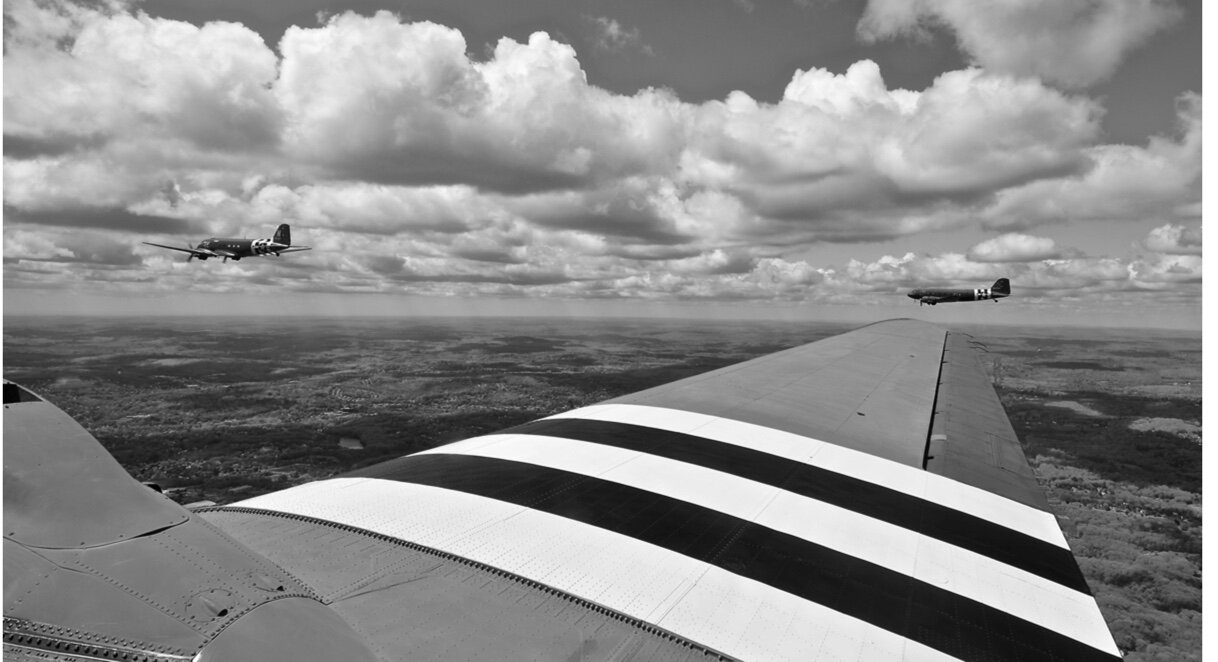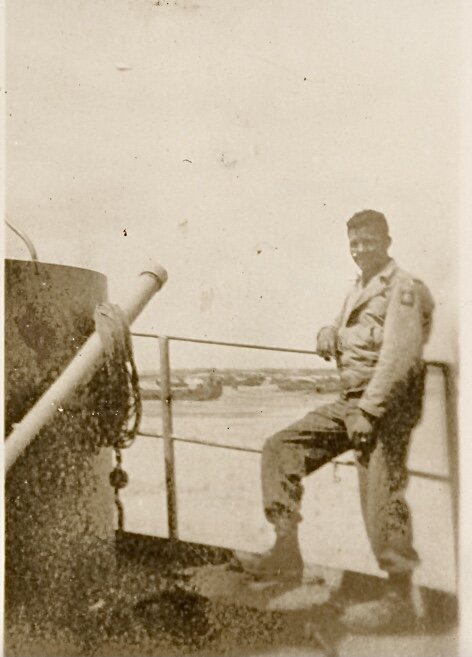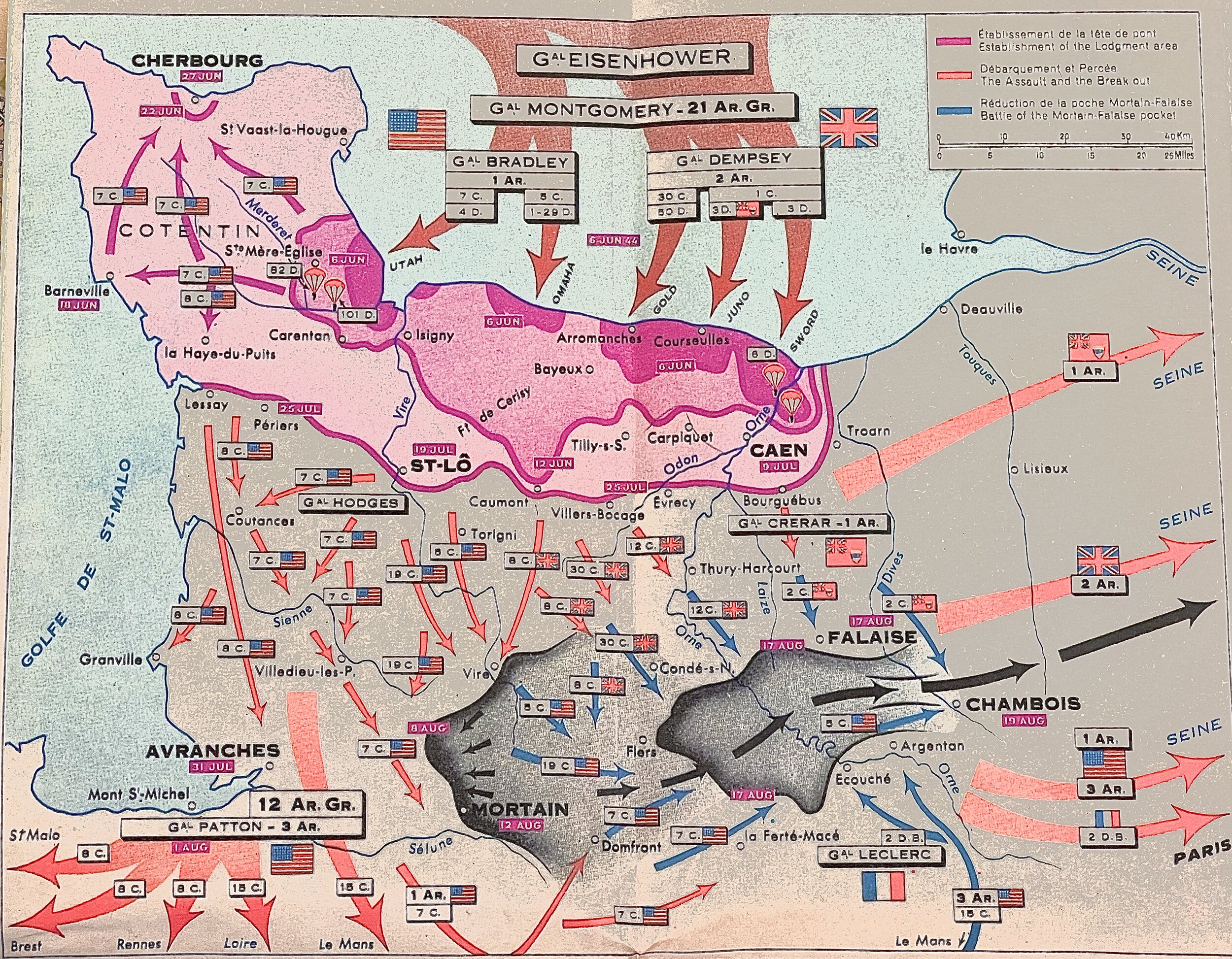D-Day Normandy
On the evening of June 6, 1944, 16 Officers and 321 enlisted men of the 319th Glider Field Artillery Battalion glided into Normandy, France as part of Mission Elmira. Landing 2 miles north of Sainte-Mère-Église, France at 2255 hours, these glider soldiers forged their place in the largest amphibious invasion in the history of warfare.
The Battalion landed in the German front lines which resulted in 2 officers and 15 enlisted men killed, 6 officers and 86 enlisted men wounded upon landing.
The following is the official Historical Record of the 319th for June and July 1944, and the official declassified Unit Journal to include support, attack plans and casualty lists.
(Click on tabs below to access each section of the report)
HEADQUARTERS 319TH GLIDER FIELD ARTILLERY BATTALION
APO 469, U.S. Army
Official HISTORICAL RECORD 319TH GLIDER FA BN
JUNE 1944
The 319th Glider Field Artillery Battalion, commanded by Major James C. Todd, departed for France on operation Neptune on 6 June 1944. The Battalion Commander, Survey Officer, Battery Reconnaissance Officers and the Battalion Survey Sergeant left from Ramsbury Airdrome at approximately 0200 hours.
Lieutenant Gelb and thirteen enlisted men left with the 320th Glider Field Artillery Battalion from Wellford Airdrome. Three enlisted men left from Greenham Commons Airdrome.
Captain Hawkins and Sergeant Sample (KIA 6/18/44) jumped with the 508th Parachute Infantry Regiment. Lieutenant Ragland and Technician Fifth Grade Bocian (attached from the 456th Parachute Field Artillery Battalion) jumped with the 507th Parachute Infantry Regiment.
The remainder of the battalion, consisting of 16 officers and 321 enlisted men, under the command of Major James T. Wilcoxson, Battalion Executive, departed from Membury Airdrome at 2137 hours in forty Horsa gliders. This part of the battalion landed at 2255 hours in the vicinity of 36.5-97.7, Sheet No. 31/18, GSGS 4347, which is about two miles north and east of Sainte-Mère-Église, France, and approximately 5200 yards from the designated Landing Zone. The gliders landed in the German front lines and the outpost lines of the 4th Infantry Division. As a result of the landings, 2 officers and 15 enlisted men were killed, 4 officers and 68 enlisted men were wounded and evacuated, and 2 officers and 18 enlisted men were wounded but not evacuated.
The elements of the battalion that assembled in this area moved to an area at 37.1-97.4, Sheet No. 31/18 NE, GSGS 4347, which was in the rear of the 4th Infantry Division front lines. This move was completed at 0500 hours on 7 June 1944; and the balance of the day was spent salvaging equipment, evacuating the wounded, reorganizing the battalion and contacting division. Upon checking with the 4th Infantry Division, it was learned that the battalion was cut off from the division.
Major Todd arrived at the assembly area at 1820 hours. Lieutenant Frank B. Poole was placed in command of Headquarters Battery and Captain Charles L. Sartain Jr. was placed in command of A-Battery.
On 8 June 1944, the battalion contacted division and moved to the division area in direct support of the 508th Parachute Infantry Regiment, in the vicinity of Chef du Pont, France. The battalion started firing at 1715 hours with one battery of seven howitzers, one of which was attached from the 456th Parachute Field Artillery Battalion.
The other howitzers had been damaged and left at the glider landing area. Other elements of the battalion that had reached the division joined the battalion on this day, under the command of Captain John W. Connelly.
On 9 June 1944, the battalion was in direct support of the 508th Parachute Infantry Regiment, which pushed west across the Merderet River. The 2nd Battalion of the 508th Parachute Infantry Regiment was cut off from the main body of the regiment and seriously threatened by a strong German counter attack. Since it was impossible for forward observers to reach the battalion, the infantry battalion commander adjusted artillery fire by use of the 300 series radio to regiment, then direct to the artillery. The artillery fire was accurately placed to within one hundred yards of the infantry, breaking up the counter-attack.
The 90th Infantry Division passed through the 82nd Airborne Division on 10 June 1944, going west toward Etienville, France. There was to be no firing by the battalion except upon order of Division Artillery Commander. An air attack at 2355 hours resulted in no damage to the battalion.
Devotional services were conducted by Chaplain Reid on 11 June 1944. As a result of the chaplain’s jump into the Merderet River on D-Day, the “Hymns From Home” used in the service were still damp. The Battalion Commander, Battery Commanders and parties made reconnaissance for new positions west of the Merderet River. The battalion was alerted to move, but the order to move was revoked by Division Artillery. On 12 June 1944, the battalion displaced to positions west of the Merderet River and was attached to 508th Regimental Combat Team, commanded by General Howell. The 188th Field Artillery Battalion was attached for reinforcing fire for the operation.
The 508th Parachute Infantry Regiment pushed south across the Douve River on 13 June 1944, after a fifteen minute artillery preparation by the 319th Glider Field Artillery Battalion, 320th Glider Field Artillery Battalion, 188th Field Artillery Battalion and the 90th Division Artillery.
A-Battery displaced to a new position across the Douve River at 1600 hours and HQ-Battery and B-Battery displaced at 2130 hours.
On 15 June 1944 the 508th Parachute Infantry Regiment was relieved and replaced by the 507th Parachute Infantry Regiment; the 319th Glider Field Artillery Battalion was attached to the 507th Parachute Infantry Regiment.
On 18 June 1944, a 75mm howitzer and section of 8 enlisted men of the 456th Parachute Field Artillery Battalion was attached to B-Battery. An overlay of scheduled fires was received on this day form the 507th Parachute Infantry Regiment, in preparation for an offensive to the west. The infantry attacked after a ten minute preparation by the artillery on 19 June 1944, and all supporting artillery fire was observed because of the many friendly patrols in the area.
The battalion displaced to new positions in the vicinity of 27.58-90.1, Sheet No. 31/18, NE, GSGS 4347, on 20 June 1944. In crossing the stream, each howitzer had to be disassembled and hauled in trucks across the temporary bridge.
Operation Memorandum No. 8, received on 21 June 1944, was suspended on the same date, and the battalion remained in this defensive position for the remainder of the month. Captain Hawkins, who had been missing since D-Day, arrived at the Battalion CP.
New clothing for all personnel was requisitioned on 22 June 1944. At 1700 hours, German artillery shells fell in the vicinity of the CP, one round falling forty feet from the S-3 tent.
Lieutenants Carey and Gutshall and their sections were removed from the 1st and 2nd Battalions, respectively, of the 507th Parachute Infantry Regiment on 23 June 1944 and placed with the 508th Parachute Infantry Regiment as liaison sections. Lieutenant Ragland was also sent to the 508th Parachute Infantry Regiment. The battalion received an issue of new trousers, shirt and one pair of socks per individual. At approximately 1740 hours one round of German artillery landed in the area of Battery B and injured three enlisted men.
On 24 June 1944, B-Battery was shelled; one enlisted man was killed and two enlisted men were slightly wounded. The battalion Observation Post was shelled on the afternoon of 28 June 1944, and Lieutenant Poole, Communication Officer, and the first sergeant of Headquarters Battery were killed; Lieutenant Blank, Liaison Officer, was injured, as were four members of his section.
Lieutenant Bourgeois was placed in command of Headquarters Battery; Lieutenant Lewis was attached from 456th Parachute Field Artillery Battalion as Assistant Communication Officer.
On 30 June 1944 seven officers from the base camp in the United Kingdom joined the battalion.
JAMES C. TODD
Lt. Col., Field Artillery
Commanding
HEADQUARTERS 319TH GLIDER FIELD ARTILLERY BATTALION
APO 469, U.S. Army
HISTORICAL RECORD 319TH GLIDER FA BN
JULY 1944
On 1 July 1944 the battalion was in position at 27.58-90.1, Sheet No. 31/18, SE, GSGS 4347, in direct support of the 508th Parachute Infantry Regiment. Batteries A and B organized new positions and displaced forward by sections at 2200 hours. At 2400 hours A-Battery was in position, ready to fire at 25.68-90.18, Sheet No. 31/18 NE, GSGS 4347; thirty minutes later B-Battery was in position, ready to fire, at 25.96-90.70, Sheet No. 31/18 NE,GSGS 4347.
The battalion supported the attack at 0630 hours on 3 July 1944 and at 0945 a message from the Commanding Officer, 82nd Airborne Division Artillery informed us that our troops occupied Hill 131. The Battalion Commander and Battery Commanders made reconnaissance of new positions, and at 2030 hours Battery B displaced forward, going into position at 22.7-88.07, Sheet No. 31/18 SW, GSGS 4347, at 2200 hours. At 2315 hours the new CP at 22.02-88.08 was opened. A-Battery and the rear echelon of Headquarters Battery displaced at 0245 hours, 4 July 1944, A-Battery going into position at 23.1-89.1, Sheet No. 31/18, SW, GSGS 4347, at 0510 hours.
The battalion supported an attack on Hill 95 by the 508th Parachute Infantry Regiment at 0900 hours, 4 July 1944. Lieutenant Carey, Liaison Officer with the 508th Parachute Infantry Regiment, and Privates Smith and Ratliff were killed. Lieutenant Gelb, Forward Observer, was wounded. Lieutenants Lewis and Ray left the CP at 1615 hours for the 508th Parachute Infantry Regiment CP, as Liaison Officer and Forward Observer respectively. At 1630 hours Lieutenant Schroeder, 87th Armored Field Artillery Battalion, attached, departed the CP for the 508th Parachute Infantry Regiment as Liaison Officer with the 507th Parachute Infantry Regiment, attached.
On 5 July 1944, Lieutenant O’Neill replaced Lieutenant Schroeder, and the 456th Parachute Field Artillery Battalion was placed in general support to reinforce the fire of the battalion. On 6 July, 1944 Lieutenants Aiken and Berman of the 456th Parachute Field Artillery Battalion, were attached to the battalion as Forward Observer and Liaison Officer respectively with the 507th Parachute Infantry Regiment.
The battalion was placed in direct support of the 507th Parachute Infantry Regiment at 0830 hours on 7 July 1944, with Lieutenants Ray, Gutshall and Fellman as Liaison Officers with the 1st, 2nd, and 3rd Battalion, respectively. On the following day they were replaced by Lieutenants Ragland, Procopio, and Engel, and Lieutenant Aiken was relieved from attached to the battalion.
The battalion remained in the same position until 11-0800 July 1944, when it was officially relieved from combat. At 1730 hours 11 July 1944, Major Wilcoxson, Battalion Executive, left the CP for the base echelon at Lubenham, Leicestershire, England. On the following day, at 1255 hours, the battalion moved out of the area, and arrived in the bivouac area at 42.5-93.8, Sheet No. 31/18, NW, GSGS 4347, at 1540 hours.
On 13 July 1944, at 0935 hours, the battalion left the bivouac area for Utah Beach, where at noon, it embarked on LST 212, which departed for the United Kingdom that afternoon at 1700 hours. The battalion debarked and entrained at Southampton, England at 1615 hours, 14 July 1944, arriving in Leicester at 2200 hours. Half an hour later the battalion left Leicester by motor convoy and arrived at Papillon Hall, Lubenham, Leicestershire, England, at 2400 hours.
JAMES C. TODD
Lt. Col., Field Artillery
Commanding
319th Glider Field Artitllery
Unit Journal
June - July 1944
(see below presented by date in a slideshow fashion - side controls to the next or previous image)




Mission “Elmira”
2400 June 6, 1944 - 2 officers, 13 enlisted men KIA, 57 men WIA and all were result of glider landings.


June 8, 1944
At 13:50, Battery A and B with seven howitzers and 783 rounds of ammo on hand, in position just north of Chef-Du-Pont.
June 8, 1944
18:32 – 22:17 Enemy tanks, Machine guns, Infantry and Counter attack neutralized, 92 rounds fired.


June 9, 1944
“G-2 reports enemy aircraft using Allied white stripes on wing and fuselage. Enemy dropping booby traps in form of blue packages size 6" x 6". German AA artillery gun positions contain time bombs generally placed near guns when evacuating. Warn troops.”


La Douve Bridge
Just outside Beuzeville-La-Bastille was destroyed June 10, 1944 as the 319th attempted to take and hold this position.









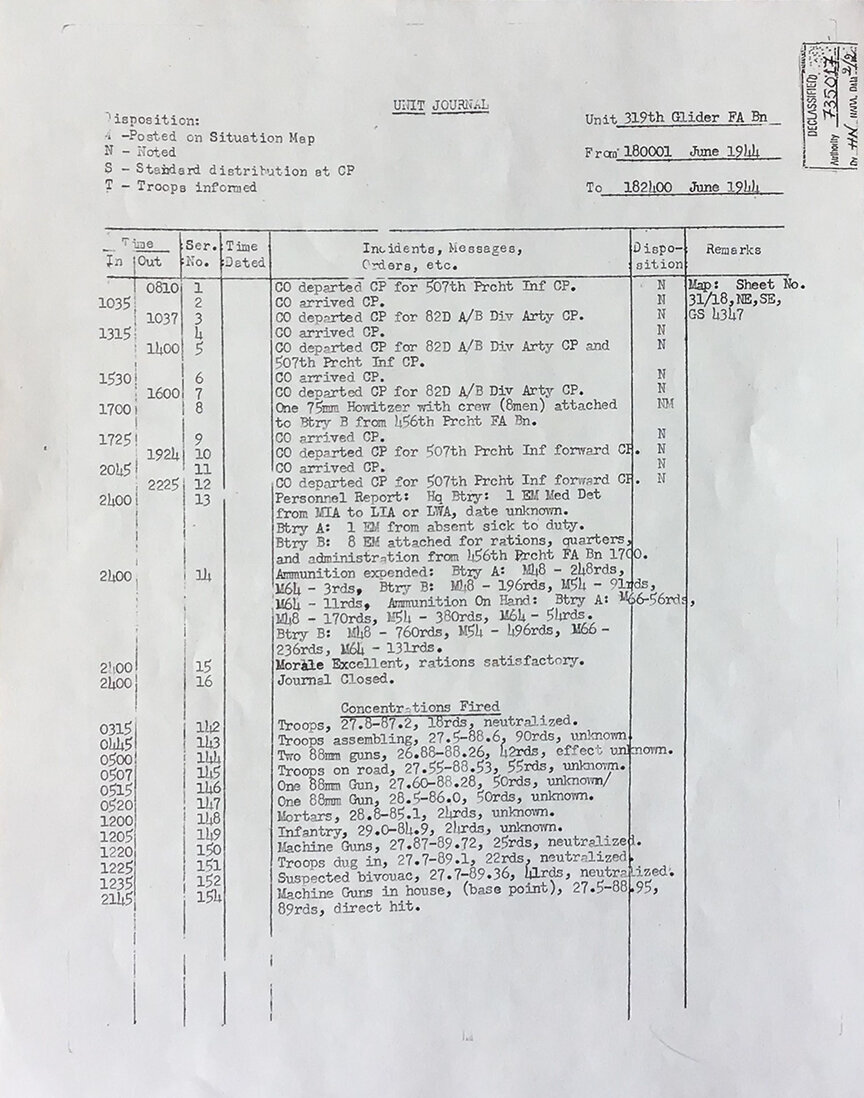






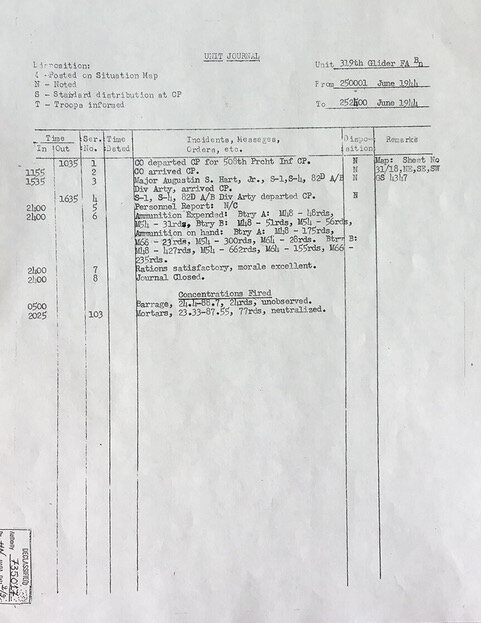
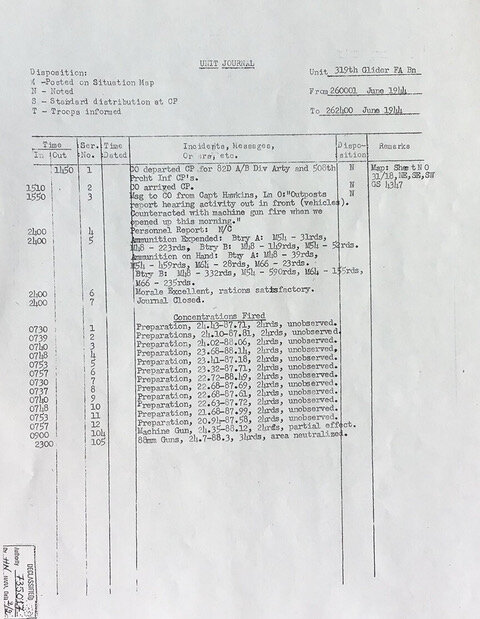
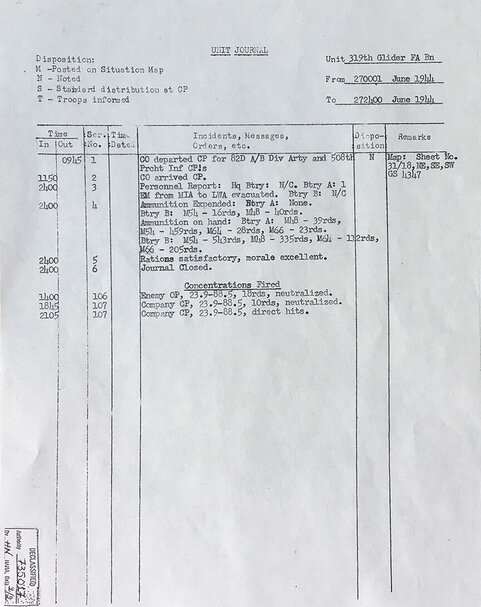
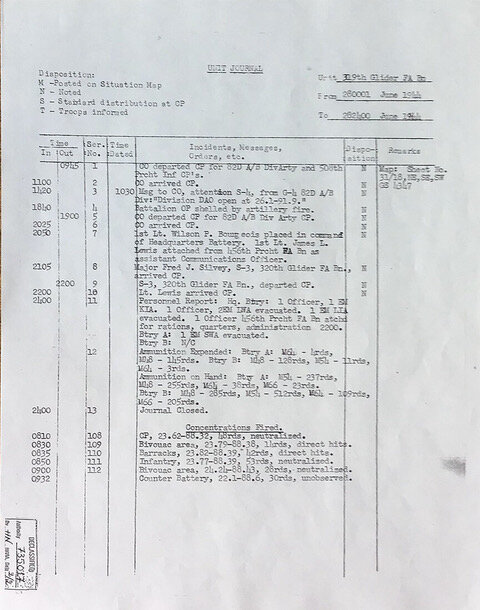


July 1944


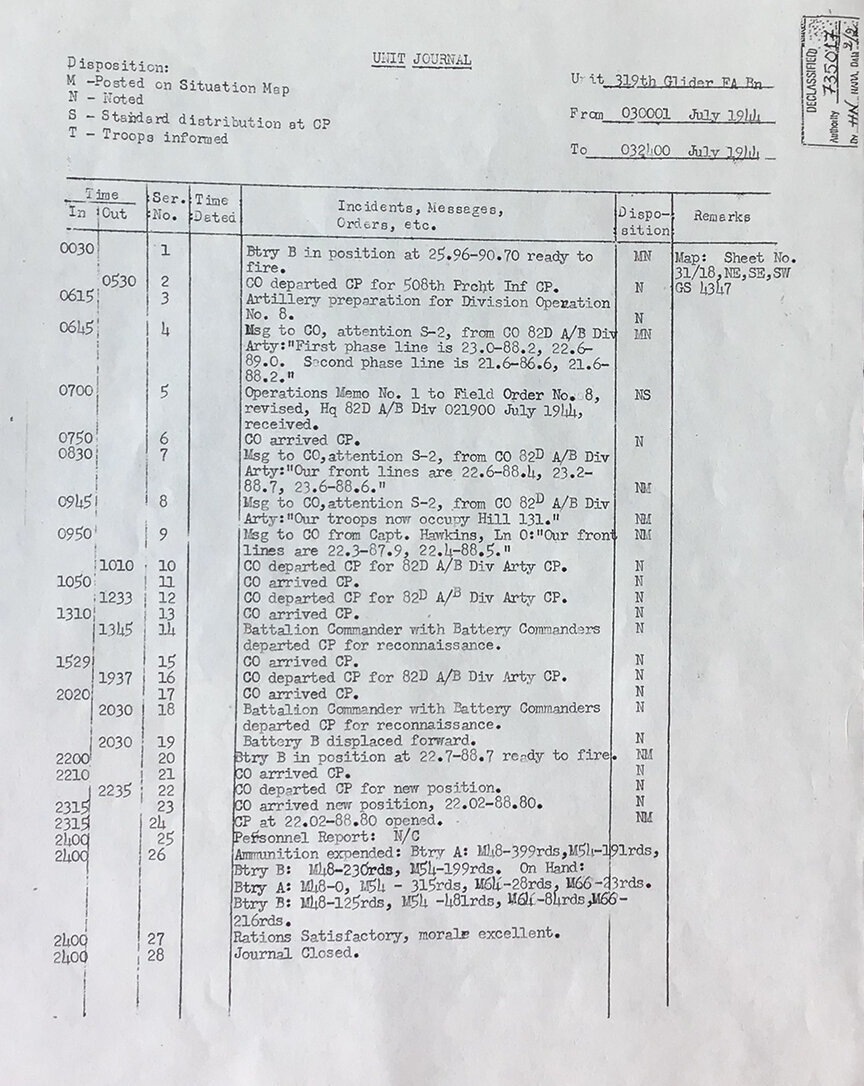
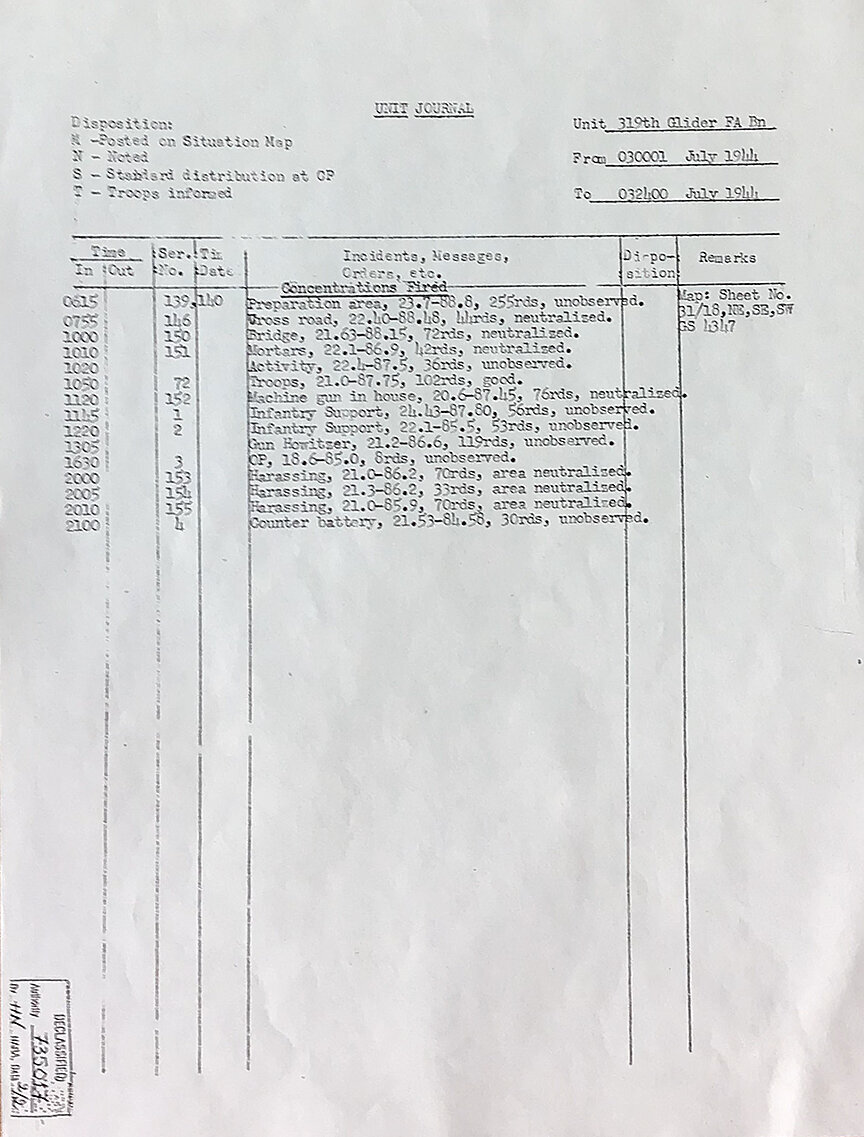




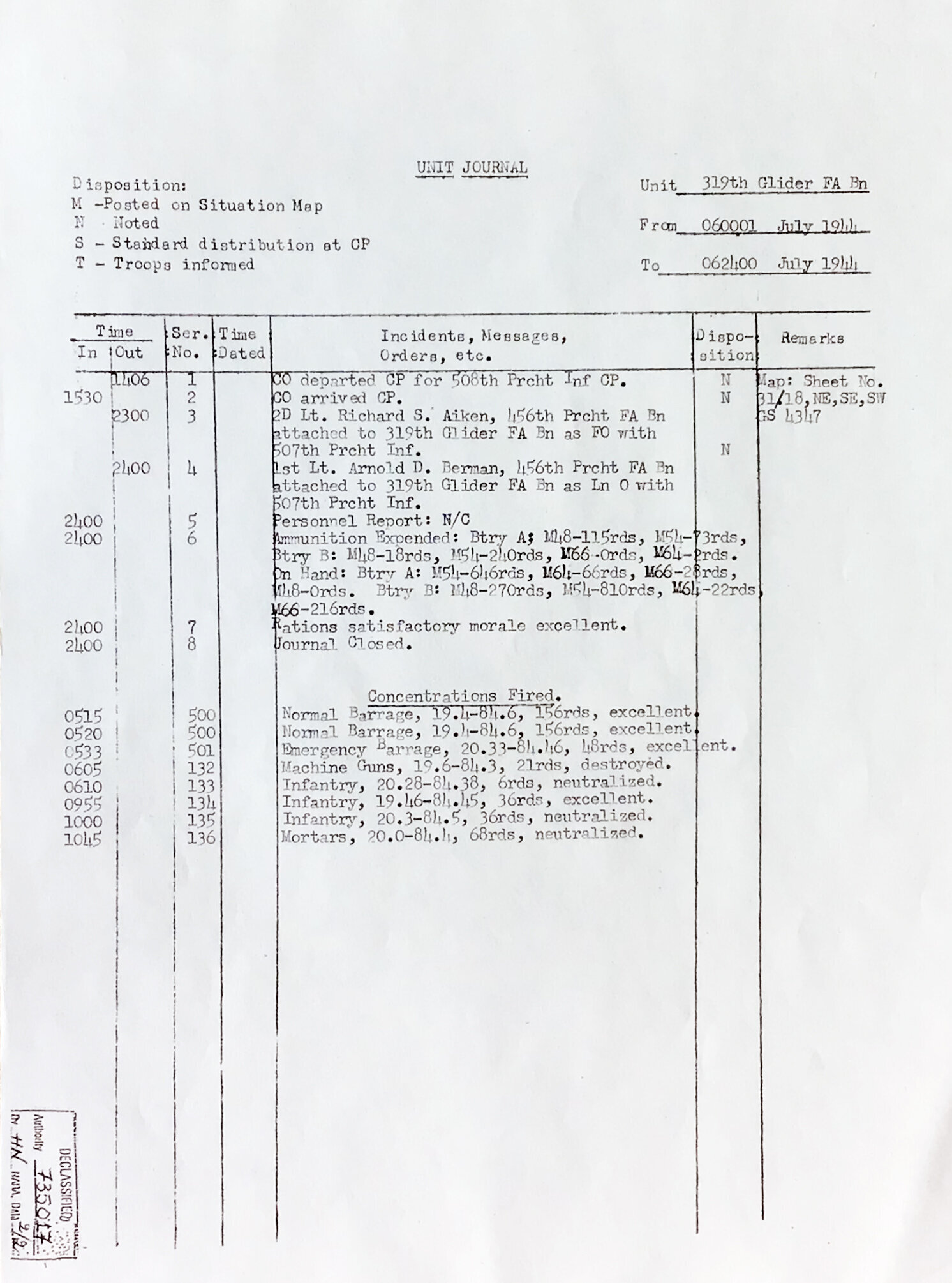







Utah Beach, July 13, 1944
After more than 5 weeks of combat the men of the 319th FA Bn aboard LST 212 standing in a “chow line” en route to South Hampton, England
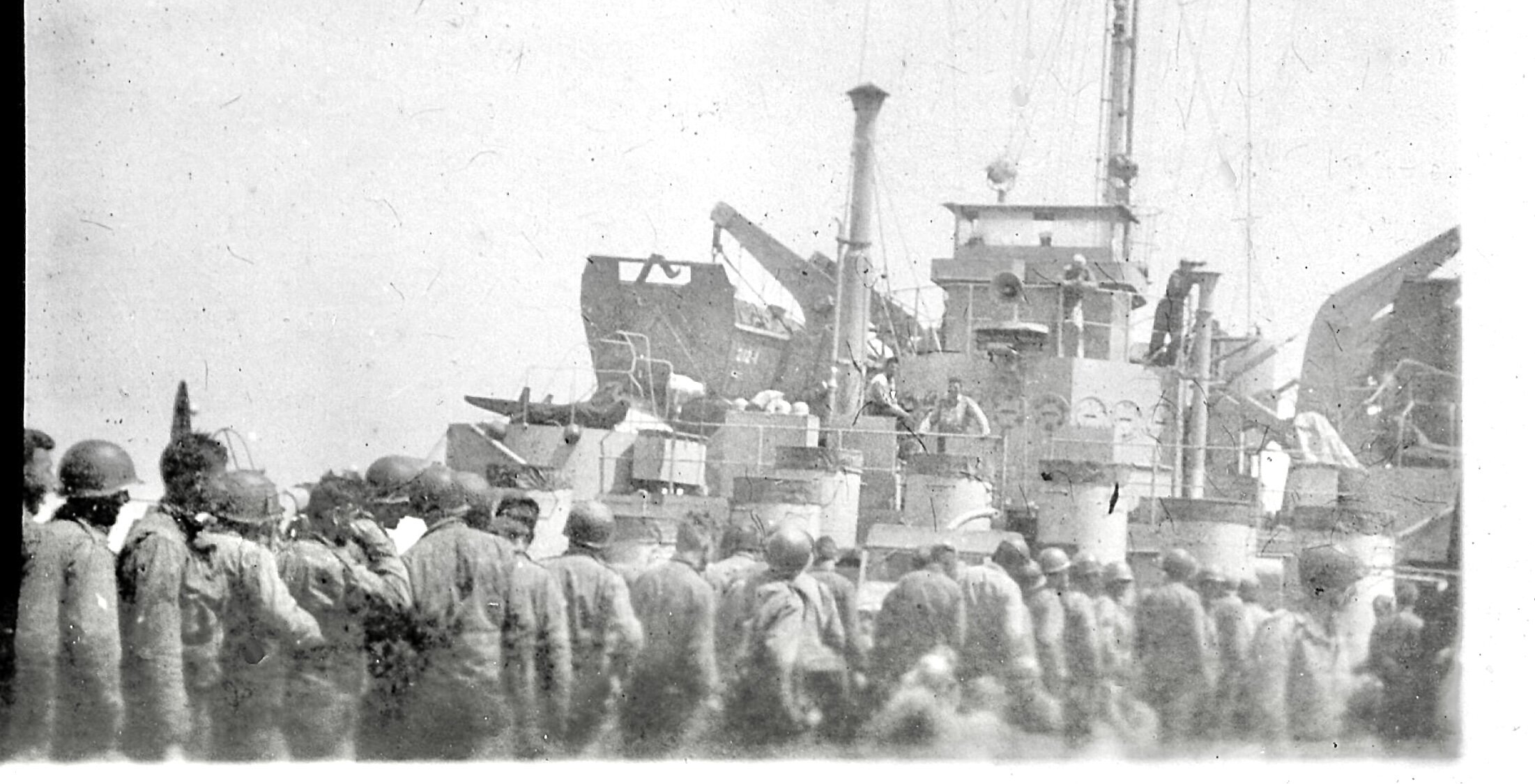
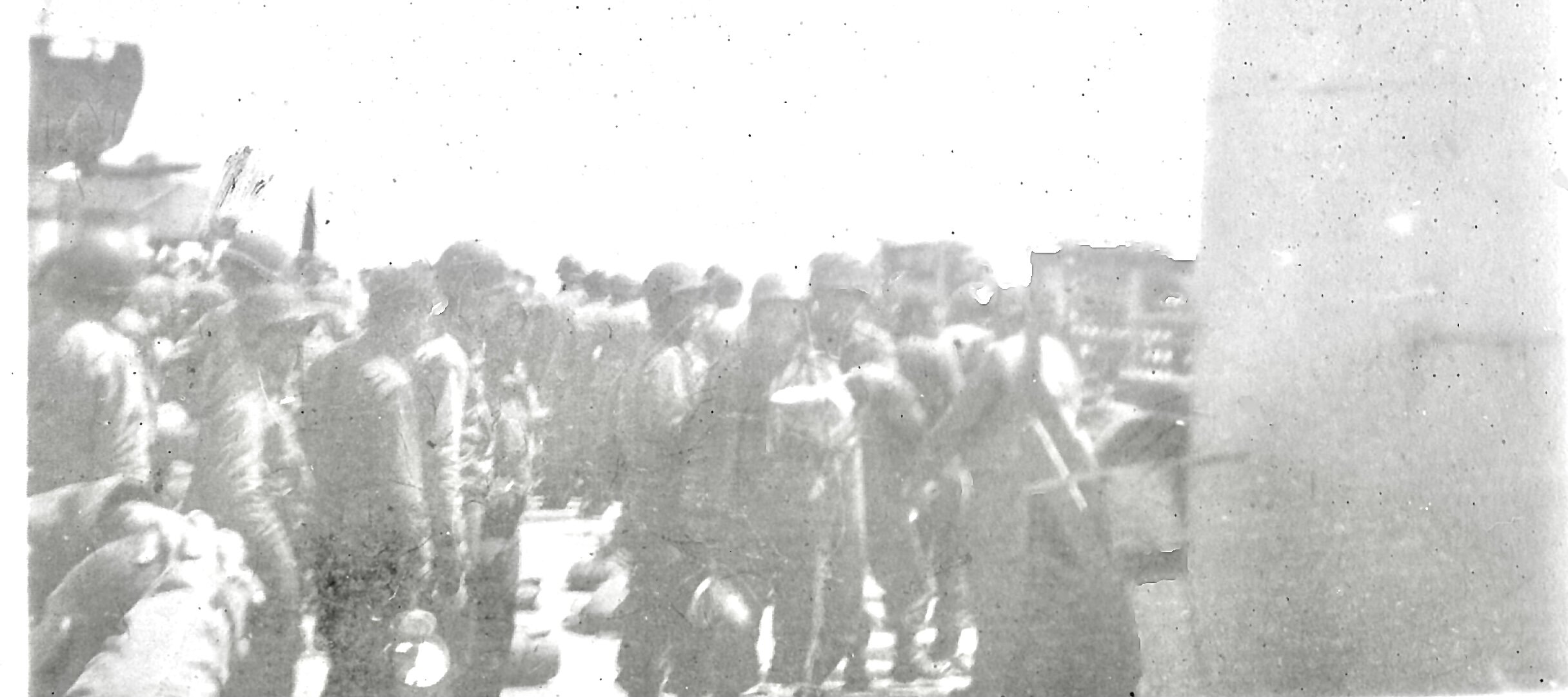
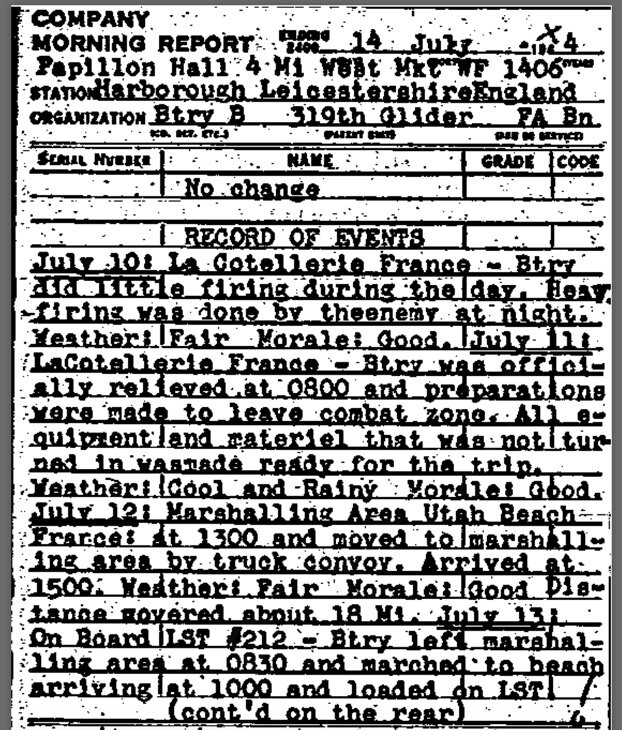


Tech 5 Robert F. Miller (Left - Below) and unidentified soldier holding a pistol on board LST 212. Note Utah Beach landing craft in the background
Normandy Casualties- July 26, 1944
Division Battle and Defense Memos
The Battle of Normandy Map
The Landings and Break Out: June 6 – August 7, 1944




